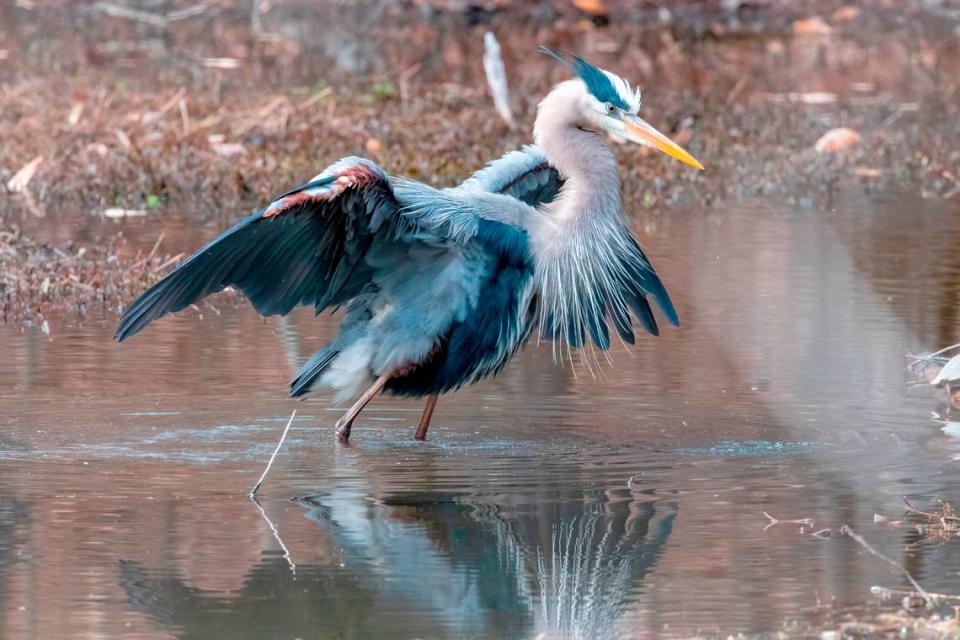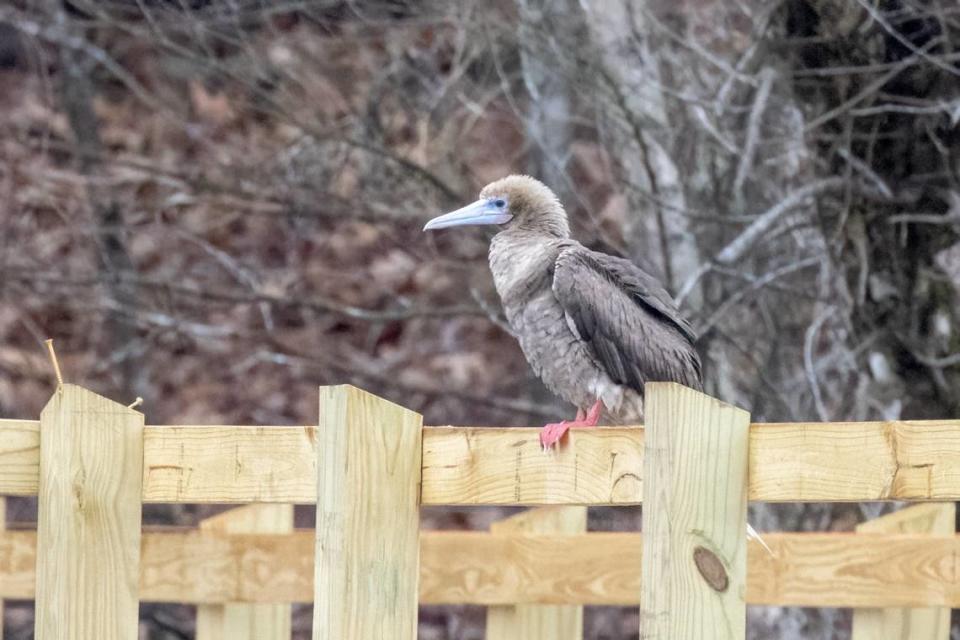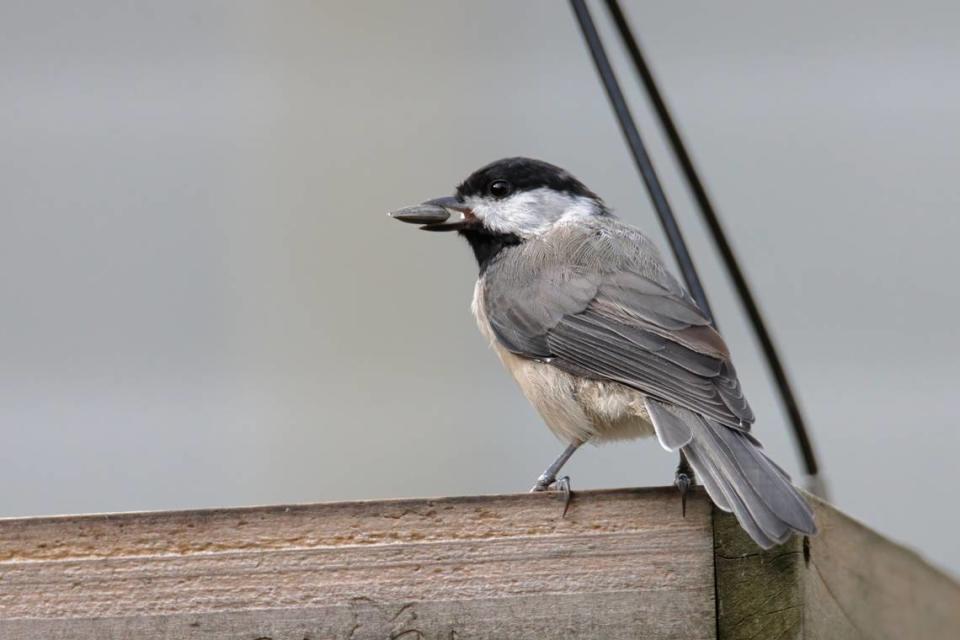What’s it like to go birding? I joined an Audubon group outing in Durham to find out
Some birders like to think Great Blue Herons carry some luck. If you see one near the start of your time birding, they say, you’re bound to have a good outing.
At 7:30 a.m. on the first Saturday of April, with wind already whipping through trees and sunlight barely able to peek through the low, dark clouds, I was hoping for a good outing. I was trekking through Sandy Creek, a popular Durham spot for birders, with a dozen of New Hope Audubon Society’s bird enthusiasts.
I already put out backyard hummingbird feeders and get excited when I see an especially vibrant bluebird while on an afternoon walk, but this was my first time “birding” — the proper term for binoculars-in-hand birdwatching.
But an excursion is not a requirement to be a “birder,” a term to describe someone who likes birds and goes a little bit out of their way to see some more of them. You can “bird” only by listening to the bird’s songs. Lots of birding involves hiking and standing for long periods of time, but that’s not a requirement either. The Feminist Bird Club in Durham, for example, holds “Blanket Birding” events to encourage bird-lovers of all abilities to enjoy the nearby birds from a cozy seat.
Take a bird walk
New Hope Audubon Society (NHAS) holds twice-weekly field trips (commonly called bird walks) early morning, switching locations for nearly every outing.
Group leaders track migration patterns to get the most bird for their buck, hoping to log dozens of birds every morning. Special outings, such as family or accessibility days, cater to birders of all experience and ability, but each outing is open to anyone who wants to join.
“Last month, we held a field trip for visually impaired birders who bird by ear, listening to songs and calls to identify,” said David Anderson, chair of NHAS’ Field Trips Committee. “But you didn’t need to be visually impaired to attend — it was for anyone who wanted to bird auditorily.”
Birding apps
Mel Green, the day’s bird walk leader, led the group through gloopy, off-trail mud in hopes of that Great Blue Heron. A seasoned birder, Green knew just where we might be able to spot one.
As we walked, a few members excitedly showed me their high-tech birding apps:
▪ The Cornell Lab of Ornithology’s eBird app is chock-full of bird identification data. (Last year, over 1.3 billion bird observations were recorded to eBird, building an ever-expanding library of identification information for birders worldwide.)
▪ The Merlin app,which is powered by the data on eBird, can listen to bird calls and tell you, based on your region, which bird is likely singing that throaty, high-pitched or squawky song. (Download eBird at ebird.org/about/ebird-mobile or Merlin at merlin.allaboutbirds.org.)
Many birders study bird songs in their spare time, memorizing collections of chirps, coos and caws so they can identify the red-headed, speckle-winged, yellow-throated or green-backed creature before even bringing their binoculars up to their eyeballs. (Their binoculars, by the way, cost hundreds, if not thousands, of dollars.)
“I feel like a detective when I bird,” a group member said.
We reached the Great Blue Heron’s probable spot. There were Common Yellowthroats and Canada Geese to spare, but no Heron. I didn’t mind. The outing was already plenty good to me.

Passionate, friendly birders in the Triangle
In early March, an exceptionally rare bird showed up at Yates Mill Pond in Raleigh. The Red-footed Booby, with its Carolina blue face and cherry red feet, had birders from all across the Triangle making up sick day excuses to see that bird through their own binoculars.
“It was the kind of bird you’d tell your boss your grandmother died over, just so you could get over there as fast as possible,” Green joked.
“A birding friend texted me about it, and I left a Zoom meeting to drive the hour and see it. My boss knows how much I love my birds, so if I say ‘I have to go right now!’ he’ll say ‘Go ahead. It’s a bird, isn’t it?’”
An hour after that text, Green pulled up to about 50 birders hoping to get an exclusive look.
Green is a part of two group chats for unusual bird sightings. The Triangle-specific online community has 236 members, and “NC Rare Bird Alert” has 463, measuring the serious birders in the area. eBird says over 5,800 birders have submitted sightings just in Wake County.

I couldn’t get enough of the friendliness on the birding trail. It was my favorite part of the outing. The group’s self-appointed tracker made sure most attendees were able to lay eyes (or ears) on each and every bird before marking it for the outing.
When members told past bird stories, they talked with fondness about the people they were birding with, sharing memories of spotting even the most common birds together.
Outing attendees helped me download their favorite apps to listen to bird calls and swipe through photos, useful tools so I could identify the birds around me for myself.
Two hours into the trek, after studying its photos and calls, I identified a Carolina Chickadee. A dozen fists pumped with glee. Green cheered, patting me on the back. I called myself a birder.

One last woodpecker
Green chose the Sandy Creek location because of woodpeckers. There are seven common species of woodpeckers in the Triangle, and members were eager to spot them all.
With my own eyes, I saw the Hairy Woodpecker’s hite-speckled wings and the Red-headed Woodpecker’s velvety, ruby face. The other species were spotted minutes into the outing, way before I was comfortable adjusting my binoculars into focus and nailing down how quickly I should bring them up to my face. (There’s a science to this, you know.)
The group saw six of the seven common species before the downpour began. Hoods went up, and most members began running to their cars, throwing quick goodbyes over their shoulders. Only four of us stuck back, watching Northern Cardinals hop along the grass in search of worms.
“Pileated!” a member called out, identifying the final woodpecker, running through the sloshy mud to get a closer look. The other two members rushed to get a peek, but couldn’t find it through the fat raindrops and shaking branches.
“Should we mark it?” Green asked.
“Nah — not everyone was able to see.”
Learn more about the New Hope Audubon Society, which covers most of Orange, Durham and Chatham counties, at newhopeaudubon.org. The groups’ twice-weekly outings take place early mornings each Wednesday and either Saturday or Sunday. Locations vary per outing.
Triangle Asked & Answered: What do you want to know?
Have a question about something in our community? The News & Observer’s Service Journalism team wants your questions for our Triangle Asked & Answered series. Reach out to us by filling out this form or by sending an email to ask@newsobserver.com.
Experts recommend these birding apps for beginner or skilled bird watchers
NC hummingbirds are migrating back for spring. When to put out feeders & how to feed
Why do flocks of black birds suddenly take over your yard? We asked an expert.


